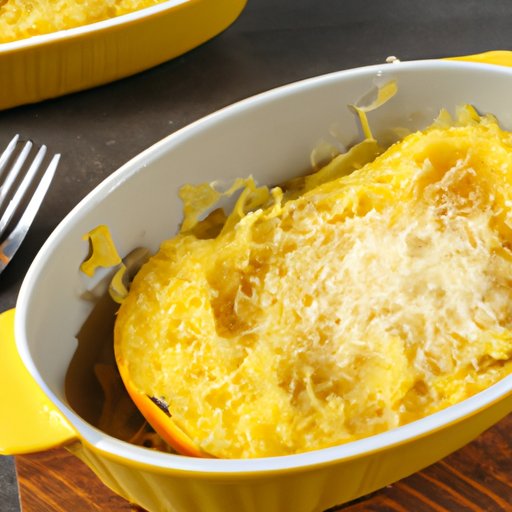
Introduction
Spaghetti squash is a versatile and nutritious vegetable that has gained popularity in recent years, thanks to its delicious taste and health benefits. However, many people still struggle with the question of how long to bake spaghetti squash and how to cook it to perfection. If you’ve ever found yourself in this predicament, don’t worry, as this article aims to provide you with a comprehensive guide on how to bake spaghetti squash perfectly every time.
In this article, we will cover a step-by-step guide to baking spaghetti squash, compare different baking methods, explore flavor profiles, offer recipe ideas, and discuss health benefits and sauce pairings. By the end of this article, you will have the confidence to cook perfectly baked spaghetti squash that is not only nutritious but also delicious.
How to Bake Spaghetti Squash
The most common method of cooking spaghetti squash is by baking it in the oven. Here are the step-by-step instructions to bake spaghetti squash to perfection:
- Preheat the oven to 400°F. Line a baking sheet with parchment paper and set aside.
- Cut the spaghetti squash in half lengthwise and remove the seeds with a spoon.
- Brush the inside of the squash with olive oil and sprinkle with salt and pepper.
- Place the spaghetti squash cut side down on the prepared baking sheet.
- Bake for 30-40 minutes or until the squash is tender and easily pierced with a fork.
- Remove from the oven and let cool for 5-10 minutes.
- Use a fork to scrape the flesh of the squash to make spaghetti-like strands.
Tips on how to know when the spaghetti squash is done baking:
- The skin should be tender and easily pierced with a fork.
- The flesh should be soft and separate easily into spaghetti-like strands.
- The edges of the squash should be lightly browned.
Suggestions on how to cut open and scoop out the seeds:
- Use a sharp, sturdy knife to cut the squash in half.
- Use a spoon to scoop out the seeds, starting at the center and working outward.

Comparison of Different Baking Methods
While baking spaghetti squash in the oven is the most common method, there are different ways to cook spaghetti squash. Here are the pros and cons of each method:
- Oven baking: Oven baking produces evenly baked spaghetti squash with a slightly caramelized flavor. However, it can take up to an hour to bake, and the heat may sometimes cause the squash to dry out.
- Using a slow cooker: Cooking spaghetti squash in a slow cooker is a set-it-and-forget-it method of cooking. The squash will be perfectly tender and moist, but it may not have the caramelized flavor that comes with oven baking.
- Microwaving: Microwaving spaghetti squash is a quick and easy method of cooking. It takes only about 10-15 minutes, but the squash may not be as tender or flavorful as oven-baked squash.
Tips for choosing the best baking method based on your specific needs and preferences:
- If you have time, use oven baking for the best flavor, but watch it carefully to avoid drying out the squash.
- If you want moist, tender squash with minimal effort, use a slow cooker.
- If you’re short on time, use a microwave, but keep in mind that the flavor won’t be as rich.
Flavor Profiles of Baked Spaghetti Squash
Baking spaghetti squash for different lengths of time affects its flavor profile. Here are some examples:
- Shorter bake times (30-35 minutes): The squash will have a firmer texture and a more savory flavor profile.
- Longer bake times (45-50 minutes): The squash will have a softer, sweeter flavor profile.
Experiment with different baking times to find the perfect texture and flavor that suits your taste.
Recipe Roundup of Creative and Delicious Baked Spaghetti Squash Dishes
If you’re looking for some inspiration on how to cook spaghetti squash in creative and delicious ways, here are some recipe ideas:
- Spaghetti squash casserole: A healthier alternative to traditional pasta casserole, this recipe combines baked spaghetti squash with ground turkey, tomato sauce, and melted mozzarella cheese.
- Spaghetti squash parmesan bake: Another cheesy and delicious recipe that substitutes spaghetti squash for pasta. This dish is baked with a blend of parmesan and mozzarella cheeses for a rich and comforting meal.
- Spaghetti squash pizza crust: For a gluten-free and low-carb pizza crust, try baking spaghetti squash mixed with eggs, parmesan cheese, and herbs. Top with tomato sauce, veggies, and your favorite pizza toppings for a healthier pizza night.
Each recipe includes instructions, ingredients, and cooking times to make your cooking experience as smooth as possible.
Health Benefits of Baked Spaghetti Squash
Spaghetti squash is low in calories, high in fiber, and rich in vitamins and minerals like vitamin C, potassium, and beta-carotene. When baked, the squash develops a caramelized sweetness that enhances its natural flavors.
Here are some tips on how to pair spaghetti squash with other healthy foods for a balanced and nutritious meal:
- Top with grilled chicken or fish for a protein-rich meal.
- Toss with steamed or roasted veggies like asparagus, bell peppers, or zucchini.
- Serve with a side of quinoa or brown rice for added fiber.
Best Sauces to Serve with Baked Spaghetti Squash
Spaghetti squash is a versatile vegetable that pairs well with a variety of sauces. Here are some ideas on how to serve baked spaghetti squash with flavorful sauces:
- Classic tomato sauce: A simple and flavorful sauce that complements the natural sweetness of the squash.
- Herby pesto: A fragrant and zesty sauce that adds a burst of flavor to the mild squash.
- Rich alfredo sauce: A creamy and indulgent sauce that balances out the tangy flavors of the squash.
Don’t be afraid to experiment with different sauces and flavor combinations to find your perfect pairing.
Conclusion
In conclusion, baking spaghetti squash is a healthy and delicious way to satisfy your pasta cravings without the added carbs. By following the step-by-step guide in this article, you can confidently bake spaghetti squash to perfection every time. Experiment with different baking methods, cooking times, and sauces to find the flavor profile that suits your taste and meets your nutritional needs.




